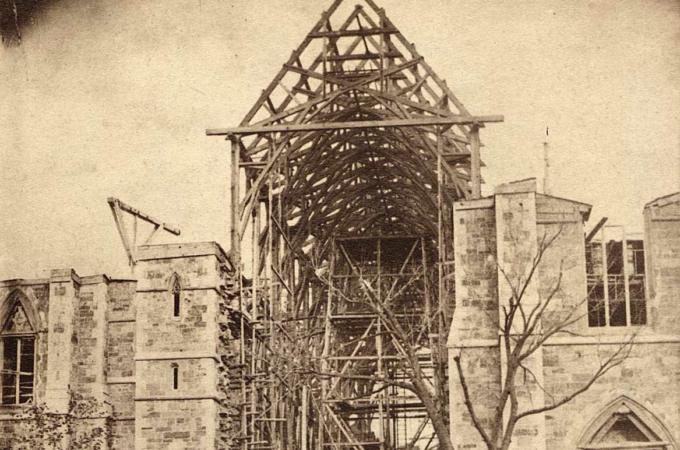Ground was broken on cathedral 150 years ago
April 29, 2016, will mark 150 years since the Diocese of Boston broke ground on the current Cathedral of the Holy Cross located in Boston's South End.
The original Cathedral of the Holy Cross was located on Franklin Street in downtown Boston. The land was acquired for $2,500 in the autumn of 1799, and Reverend Francis Matignon announced the purchase after High Mass on Christmas Day of that year. Charles Bullfinch, who had recently designed the Statehouse on Beacon Hill, was hired to design the church.
Construction was delayed several times due to a lack of funds, but with the generous support of both the Catholic and non-Catholic communities, construction was eventually completed in the autumn of 1803. Bishop John Carroll of Baltimore arrived for the dedication, which took place on Thursday, Sept. 19, 1803, the Feast of St. Michael the Archangel. In 1808, with the creation of the Diocese of Boston, the church was elevated to a Cathedral, and home church of the Bishop of Boston.
Over the next several decades, however, the growth of churches, parochial schools, and other institutions was far outpaced by the growth of the Catholic population. For instance, upon arriving in Boston in 1825, Bishop Benedict Fenwick noted that there were only eight churches in all of New England, and only the Cathedral appeared adequate for such a purpose. The problem lingered, and by the late 1850s Bishop John Fitzpatrick took steps towards building a larger Cathedral that would represent the growth of the local Catholic population.
The recently developed South End was chosen for the new site, and with the reluctant consent of the Cathedral's parishioners, he sold the Franklin Street site to help fund this new project. A final Mass was said at the Franklin Street site on Sept. 16, 1860. New York architect Patrick C. Keely was hired to design the new cathedral, but in November of that year Abraham Lincoln was elected president. Over the next several months, 11 states seceded from the Union and the nation plunged into civil war. The war placed construction of the cathedral, and many other projects, on hold indefinitely.
In 1866, Bishop John Williams succeeded Bishop Fitzpatrick, who died on Feb. 13 of that year. Bishop Williams was determined to complete the cathedral, and met with Keely to review the original plans from 1860. They broke ground on April 29, 1866, and the church completed nine years later, in 1875.
The building is in English Gothic Style, and in contrast to the original, its size was meant to match that of the cathedrals in Europe, such as Notre Dame in Paris, and St. John of Lateran in Rome. The original plans intended for the building to have two towers, but the design was amended to include one tower due to financial constraints. So it would not be forgotten, the high altar from the Franklin Street church was installed in the basement chapel. Fittingly, as he had started the project, the remains of Bishop Fitzpatrick were reinterred in the Cathedral crypt.



















